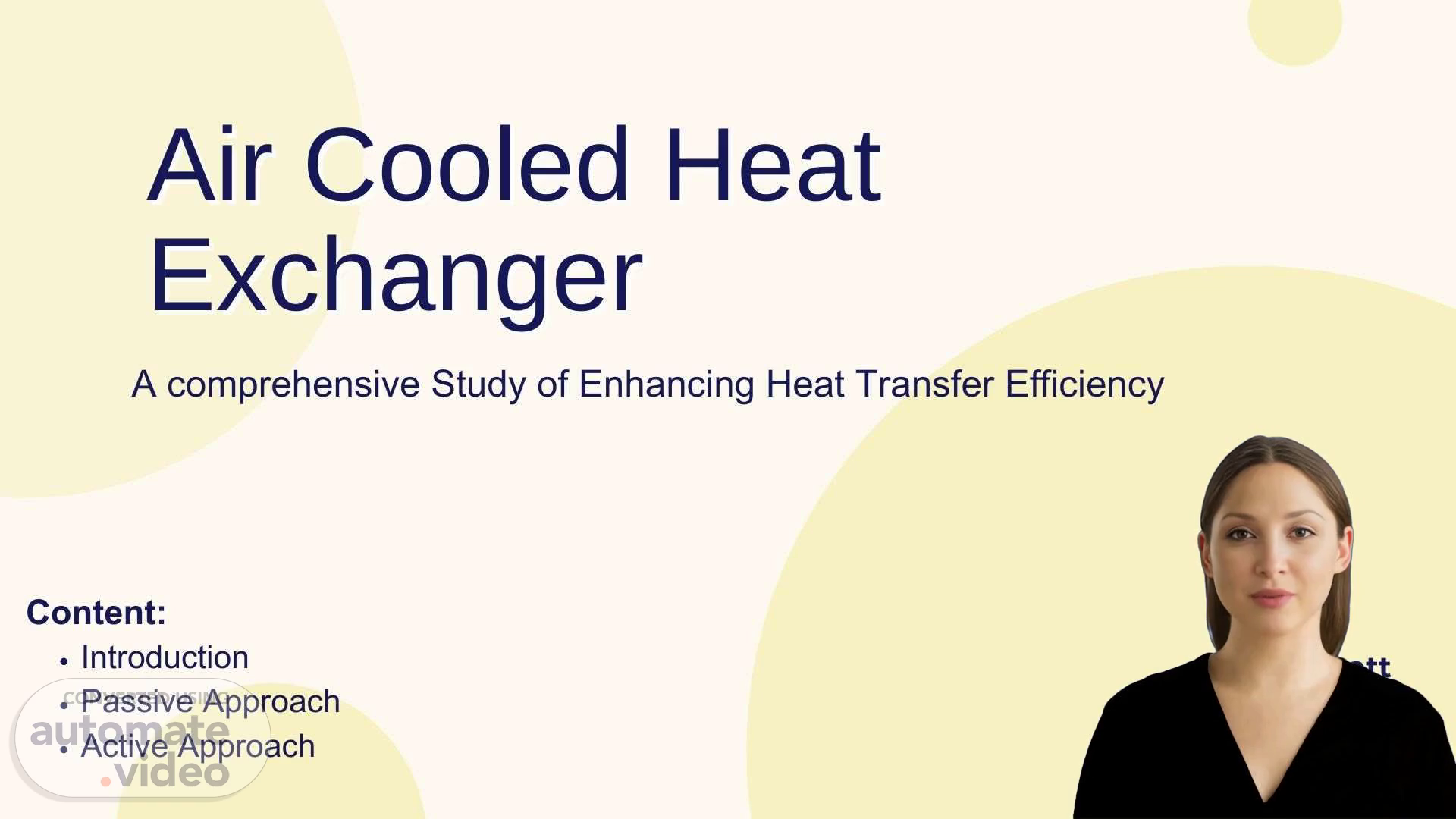Scene 1 (0s)
[Virtual Presenter] Good morning everyone. Welcome to our presentation on Employee Engagement & HR. Today we will be discussing how our company supports employee engagement and how we nurture a productive and successful working environment. Let's get started!.
Scene 2 (15s)
[Audio] Heat exchangers are a vital component of numerous commercial and industrial operations. A-C-H-E-s (Air-Cooled Heat Exchangers) utilize air in order to reduce the temperature of hot fluids. A-C-H-E-s comprise of a tube bundle a sequence of tubes where heat transfer occurs joined to a plenum chamber that houses a fan. This fan pushes air over the tube bundle causing it to cool as the air passes over it. This fan-driven air flow sets A-C-H-E-s apart from other types of heat exchangers. A-C-H-E-s are commonly used in cooling towers which are used to remove heat generated in industrial processes as well as in other operations such as boiling drying and condensing..
Scene 3 (1m 3s)
• Limitations of ACHEs Anti-Corrosive • Remedies of Those Limitations Nanocoatings 1 . Active Approaches 2. Passive Approaches Tubes with Fins 4. Passive Approach 3. Active Approach Warm Air Cool Process Fluid Ambient Air 5. Passive Approach.
Scene 4 (1m 14s)
[Audio] Discussing passive approaches to improve the efficiency of air cooled heat exchangers circular fins are a common solution however they come with certain drawbacks including pressure drop fouling and low heat transfer coefficient. Modifications of circular fins like tubes with circular fins and non-uniform thermal performance have been done to address these issues..
Scene 5 (1m 39s)
[Audio] The slide deals with passive approaches and elliptical fins which can be used to improve air cooled heat exchangers. Elliptical fins lead to decreased air side pressure drop by 31% increased air side heat transfer by 14% and a decrease in overall weight of 23%. The R2 value is 8..
Scene 6 (2m 2s)
[Audio] The company has done comprehensive research to create an optimized design of star-shaped fins. This design was experimentally compared to annular fins resulting in a 30% increase in the Nusselt number and a 23.8% decrease in overall weight. After optimization of air convection heat exchanger (A-C-H-E-) the decrease was further increased to 5.5%. Furthermore a 3D model with a geometry of Ø27ø 0.5a and 0.5b (Figure 1) was developed to improve performance..
Scene 7 (2m 45s)
[Audio] In regard to passive approaches used in heat exchangers research on perforated fins with different angular locations demonstrated the optimal performance at an angle of 600. Moreover perforations on star-shaped fins reduced weight and increased heat flux. Regarding the studies conducted on spiral-finned tube heat exchangers it was confirmed that the pressure drop was reduced with perforations. This slide presents the geometry and 3D model of the perforations with star-shaped fins as well as the perforations for spiral finned tube heat exchangers..
Scene 8 (3m 24s)
Active Approaches 1 .Machine Learning and Advance Control aspect of ACHEs: • What is ANN? • How ANN is utilized in the advance control aspect? Applications of ANN in ACHEs • Future possibilities of Implementing ANN is real time analysis and else. Input 1 Input 2 Input 3 Nodes xn Artificial Neural Network Neuron 13. ANN Approach Output.
Scene 9 (3m 39s)
[Audio] Nano-coating is a cutting edge technology in application development services allowing us to enhance the performance of A-C-H-E-s with simple and inexpensive methods such as spinning dipping and spraying. We also use advanced coating techniques like Self-Assembled Monolayers (S-A-M--) Chemical Vapor Deposition (C-V-D--) and ion implantation though they are more expensive. Nano-coating creates a hydrophobic surface that can't be achieved using other methods..
Scene 10 (4m 12s)
[Audio] Vortex generators are a form of active flow control employed to modify the performance of air conditioning heat exchangers (ACHEs). They comprise two main types static and dynamic vortex generators which produce a whirling effect on the air flowing through the ACHEs thereby reducing the pressure drop across the exchanger and leading to a higher efficiency. Heat regeneration is another active method of decreasing energy consumption in ACHEs. It is divided into three types recuperation heat recovery and heat regeneration involving the use of heat transfer strategies and thermodynamic optimisation to store and recycle energy from the exhaust air. Thus the use of active flow control and heat regeneration techniques can result in enhanced energy efficiency in air conditioning heat exchangers..
Scene 11 (5m 6s)
[Audio] We can observe the overall analysis of various fin designs applied for hybrid cooling systems on this slide. There have been design advancements operational strategies and material changes to reduce weight and boost heat flux. Data is represented for elliptic toothed spiled and star formed fin types. Environmental concerns and the total effect are also taken into account. Analysis of this type allows us to determine that hybrid cooling systems are a practical way to reduce weight and enhance the heat flux efficiency..
Scene 12 (5m 43s)
Thank You.
